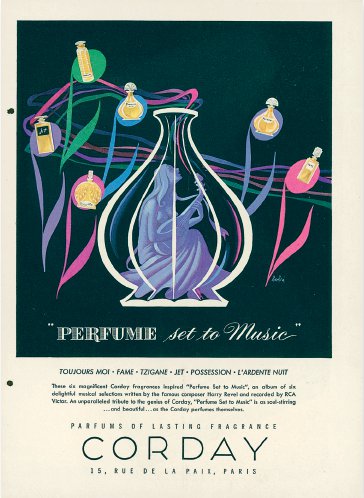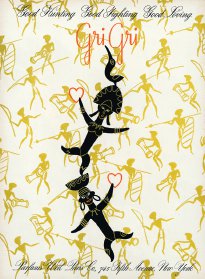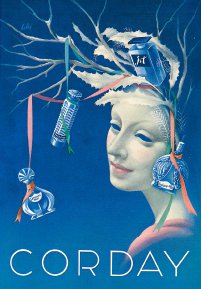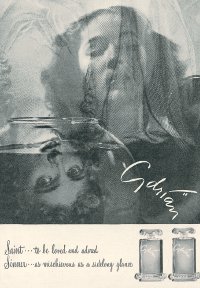Scent and Subversion (13 page)
Read Scent and Subversion Online
Authors: Barbara Herman


Composer Harry Revel claimed that Corday’s perfume “Toujours Moi” was the inspiration for turning scent into melody. The result was his interpretation of Corday perfumes into theremin-driven tunes that the album boasts “is probably the only successful attempt to capture and reproduce … the ‘sounds’ of fragrance and scent.” (The operative word here is
probably
.)
There is something savage, fierce, and raw about Vent Vert, recalling the first lines of T. S. Eliot’s poem, “The Waste Land”: “April is the cruellest month, breeding / Lilacs out of the dead land, mixing / Memory and desire, stirring / Dull roots with spring rain.” Hope, desire, rebirth, renewal—these are all primal feelings, and the perfume respects that with its scent of freshly picked flowers, a green soapy rose, and bent stems with crushed herbs mixed in for spiciness.
Top notes:
Galbanum, citrus oils, gardenia, leafy green, peach
Heart notes:
Rose, lily of the valley, hyacinth, orris, jasmine
Base notes:
Oakmoss, vetiver, styrax, musk

In this 1940s advertisement, a “blackamoor,” the racist figure whose image was ubiquitous in the first part of the twentieth century, opens a bottle of Jet perfume.

Named after a voodoo good-luck talisman, Gri Gri perfume by Weil trades in stereotypical African totem imagery.
by Robert Piguet (1948)
Perfumer:
Germaine Cellier
Germaine Cellier had a camp sensibility about gender and perfume, evidenced in the gender hyperbole of Bandit vs. Fracas, the butch/femme couple of the vintage perfume world.
If Bandit perfume was meant for the butch lady in leather with the sidelong glance and the cigarette dangling out of her mouth, then voluptuous Fracas pays tribute to over-the-top femininity of the Marilyn Monroe / Anita Ekberg variety. Green and bright in its top notes, followed by a deluge of white flower notes resting on a creamy, decadent bed of balsams and musk, Fracas is almost a gourmand version of white flowers. Its carnation evokes images of cloves woven into flower garlands, providing sparks of red-hot heat amidst creamy white florals.
A “fracas” is a noisy, disorderly brawl, and in French, Italian, and Latin, it means to shatter (fracasser), to break (frangere), and to make an uproar (fracasso, fracassare). In Germaine Cellier’s hands, this means that the floral category, usually a proper and ladylike one, gets subverted. This quintessential sex-bomb floral is meant to disturb and not merely to seduce, to disrupt and disquiet in addition to subduing. Fracas’s beauty is not quiet and demure; it enters the stage like an attention-getting troublemaker.
Madeleine de Madeleine, Mollie Parnis by Weil, Dior’s Poison, and sheer little drugstore Jovans have quoted Fracas, but she remains the iconic diva, the Marilyn Monroe of floral perfumes. (The reformulation isn’t as rich and voluptuous as the original. Like Fidji’s reformulation, it lacks the depth of the original base notes.)
Top notes:
Bergamot, mandarin, hyacinth, green notes
Heart notes:
Tuberose, jasmine, orange blossom, lily of the valley, white iris, violet, jonquil, carnation, coriander, peach, osmanthus, pink geranium
Base notes:
Musk, cedar, oak moss, sandalwood, orris, vetiver, Tolu balsam
by Nina Ricci (1948)
Perfumer:
Francis Fabron
The vintage L’Air du Temps (“Spirit of the Times”) in the eau de parfum concentration has one of the most subtle, beautiful carnations I’ve ever smelled in vintage perfume. In Roger & Gallet’s Blue Carnation, that flower radiates from its heart with a peppery force; it is a clove-heavy carnation on steroids. In Caron’s Bellodgia, its cloveyness is woven into a floral garland as an accent or spice; the florals to the untrained nose are
practically unaccompanied. But in L’Air du Temps, fruit and floral notes are balanced with the carnation’s unmistakable spicy, aromatic clove, and their balance creates an incredibly romantic, beautiful, and joyous perfume. As it dries down, woods and balsamic notes add a sensuous warmth.
Like Fleeting Moment by Balenciaga (1949), there is a gentle, wistful quality to L’Air du Temps. The name of the perfume references the beginning of the world’s recovery from World War II, when there was hope for a new prosperity and peace, represented by the Lalique bottle with its kissing doves on the stopper.
My first introduction to L’Air du Temps was through my grandmother. It was her favorite scent. When I resniffed L’Air du Temps for the first time in years, I had a vintage from the 1970s, an eau de toilette, which was much sheerer and had a less emphatically joyous character than the older version. If the 1970s version was a little wan, I can’t imagine what reformulations have done to it.
Top notes:
Bergamot, rosewood, neroli, peach, spice notes
Heart notes:
Clove bud, Rose de Mai, ylang-ylang, orris, orchid, lily
Base notes:
Sandalwood, musk, vetiver, benzoin, cedar, amber, moss
by Tuvaché (1948)
Tuvara is a soft, light, Oriental perfume with herbal top notes of chamomile, lavender, and barely perceptible florals. Myrrh, creamy labdanum, and vanilla with the match spark of woods and moss make up the drydown.
Top notes:
Chamomile, bergamot, lavender, aldehydes
Heart notes:
Ylang-ylang, geranium, jasmine
Base notes:
Sandalwood, myrrh, vetiver, labdanum, oakmoss, musk and patchouli, vanilla, patchouli, incense
by Creed (1949)
Ambre Cannelle (“amber cinnamon”), Creed’s animalic, spicy, and warm-ambery-powdery fragrance smells like a good-girl perfume mixed in with perspiration and lust.
At first whiff, I was hit with skanky amber—something a little rude, civety, and haunting. The powdery aspect, as well as the skanky quality, could be ambergris. Or it could be Ambrox. Whatever it is, it is heavenly. (It has recently been discontinued.)
Top notes:
Cinnamon leaves, juniper berry
Heart notes:
Rose, cinnamon, bay leaves, coriander
Base notes:
Ambergris, musk

In this beautiful 1940s-era ad, Corday perfumes hang from the branches adorning the head of a perfume muse who stares dreamily off into the distance.

Witchery
seems to have been a buzzword in 1940s perfume ads, signifying women tapping into a powerful and subversive form of seduction. Here, it might be a euphemism for prostitution!
by Robert Piguet (1949)
Calypso’s rose starts off shy, but soon, this delicate creature flanked by green notes just blooms. That would be enough to make Calypso worth remembering, but its second act is even better. Along with some spice, an unmistakable animal note (ambergris or civet) musses up our sweet rose’s hair and slips her glasses off. Calypso, in other words, is a very sexy rose.
Notes from
1964 Dictionnaire des Parfums de France:
Rose, jasmine, carnation, gardenia, patchouli

Good girl, bad girl. Light and dark. White Shoulders and Menace. You get the picture.

Creating a good girl–bad girl split wasn’t just one way to keep women confused; it was also good for business, as perfume brands could find an excuse to market two perfumes to one woman. Adrian’s 1946 Saint and Sinner advertisement depicts this schizophrenic state of affairs.
